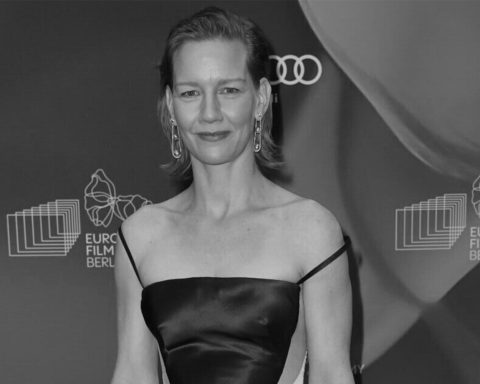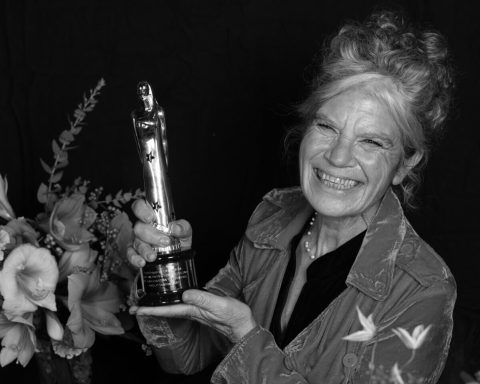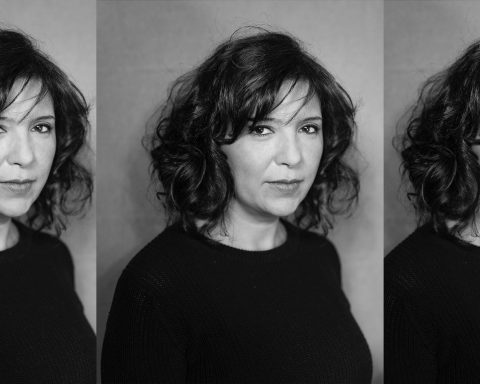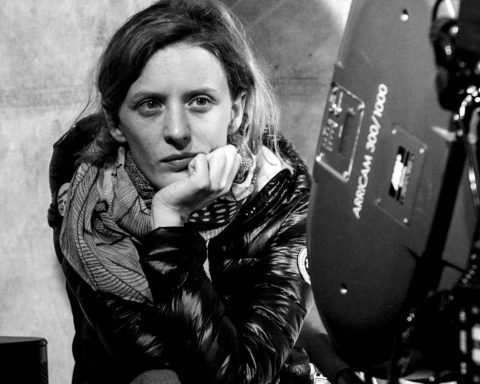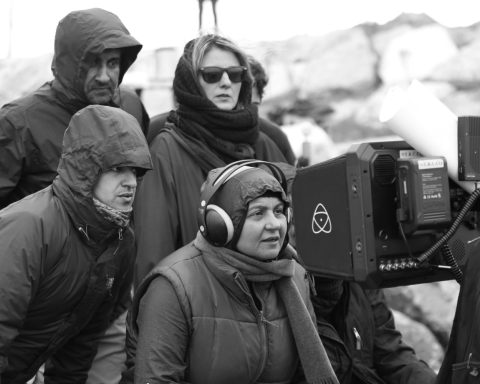Tuija Halttunen is a Finnish documentary filmmaker who has worked in the film industry for over twenty years. Her documentary “Neighbours” was nominated for the 2013 Prix Europa and her documentary “State of Mind” received a State Quality Award in 2007. Halttunen’s short documentary “Heaven and Earth” won the main prize at the Tampere Film Festival in 1995. From 2010 to 2015, she worked as a regional artist in the Arts Promotion Centre in Finland.
Tara Karajica talks to Tuija Halttunen about feminism and film and her latest documentary, “How to Kill a Cloud,” in which a Finnish scientist takes on a multimillion-dollar project to make rain in the desert, but soon becomes caught in an ethical dilemma between research, finance and the environment. The film premiered at this year’s CPH:DOX Film Festival and is now playing in the Europe! Voices of Women in Film program at this year’s Sydney Film Festival and is shortlisted for the Sustainable Future Award.
How did you get into filmmaking?
Tuija Halttunen: I was a bit of a late bloomer. After studying Philosophy at University, I went to Film School at twenty-eight. I was always into storytelling since a very young age. I wrote my first play (five minutes or so long) at the age of ten. However, I come from a small paper factory town and, in my youth, the world and life outside the paper factory seemed unreachable. In the 1980s, the leap from a small factory town where there was no culture other than the culture of men being drunk every Friday and Saturday was big. It took me quite a long time to understand that films are not made by some odd entities living in an odd reality, but that I could make films too – tell stories, which was my ambition since a very young age.
How did How to Kill a Cloud come about?
T.H.: Clouds have been tickling my curiosity for over a decade since I read a book about clouds and thought I should make a film about them. However, it was difficult to find the point of view and angle. In January 2017, I heard about a Finnish scientist who received a grant of 1,5 million dollars from the United Arab Emirates to study how to manipulate clouds and make it rain. I knew immediately this was a story I wanted to tell. From the beginning, it was clear to me that I didn’t want to make a classic science, film but rather to observe ambition, integrity and power and follow a single person in the midst of all that.
Hannele Korhonen is one of the few women in the film, a fish out of water in a traditionally male space in the UAE and the science world. She sticks out because of her wry humor as well. Can you talk about her? How do you see her? How did you approach her?
T.H.: I see Hannele the way she is in the film; it is my perception of her as film character, but in real life she is, of course, much more. A film can show only some sides of a character and it is always the simplification of a true person. My goal was to portray Hannele as a whole human being anyway. In her case – her being a woman – it means certain things. They can be seen and found in the film, as you have. She is one of the few women in that branch of science facing a big challenge in a culture that differs a lot from the Western, Scandinavian world she is from. I found Hannele highly intelligent, very talented in her work, assertive, reserved, quick-witted, quite controlling and very ambitious and honest. Absolutely one of the best in her field, absolutely one of the most intelligent people I have ever met; I often felt stupid in her company.
I approached her at first by email and then we met face to face and I introduced my idea for the film.
The film tackles the clash between cultures, cultural knowledge, stereotypes and perceptions of women, moral questions and power and how it affects people. Can you comment on that?
T.H.: I’m very happy that you have found those elements in the film, elements that were very important for me to bring out when making the film. These are elements we all have to face – preferably also recognize – in our daily life and I had the chance to process and tackle them in quite a unique story. Having this many complex issues, however, meant a film with many layers – different levels which we had to bring into the story. It meant paying a lot of attention to visual storytelling and sound as well and making sure that all these different levels of the story were run in balance and/or simultaneously at least in one of the elements of storytelling on film. I really had to pay even petty attention to all different film and storytelling devices so that we were able to keep all those different layers in the film and yet make a coherent film. Of course, you always pay attention to them when making a film, but in this film we thought them through over and over again in every scene and in every sound and image cut so that we could run the idea of a multi-level story throughout the film.
You start with the science and life of a scientist and then you move on to ethical questions, delving into whether Hannele has entered a Faustian pact, thus putting her scientific integrity at risk and you tackle the issue of science vs. ethics and the ethical dilemmas of geo-engineering. Can you talk about that and this choice of narrative?
T.H.: A scientist is driven by a passion to understand the world. And, an idealistic need to make the world a better place is often at the core of his or her science. Yet, when given the chance to do the thing he or she loves the most, it is easy to become blind to the wider issues. Pure science does not stand alone. Human ambition and the need for recognition often drive the choices we make. I wanted to observe how this affects a single individual: a scientist faced with moral ambiguities. This point of view of science-making is very natural to me, so making that the narrative core of the film was quite natural.
Soon, I also learned that we are not that different, filmmakers and scientists: we have the same struggles to deal with like funding and passion for our work and putting our own personality into the work. It guided my narrative choices because I felt this is an area I know.
When it comes to the atmosphere of our planet, one cannot avoid pondering on international politics. There was clearly an ethical element to my story and, quite early on, I decided that a certain moral ambiguity had to run throughout the film in the background. The film also had to deal with humanity’s relationship both to nature and to countries: the tension between science, the government and the climate. At the same time, recognizing that this was the story of one individual. To bring everything together, I decided to use all the filmmakers’ tools I could as long as I stayed away from preaching: rather I would give the audience the tools to think for themselves.
Many of the choices are made in the creative process and that is very difficult to analyze by oneself. Anyway, I feel the story is there and it is told the way I felt it had to be told. This choice of narrative was quite obvious to me right from the beginning – after meeting Hannele, learning about her science and visiting the U.A.E for the first time. I don’t quite remember having any other narrative ideas along the way, which is actually quite unusual; more usual is to struggle between many different narrative ideas. But I did have an idea to break the timeline of the film. When we started editing, I wanted to make it more like a circle timeline with two different time levels. But after a short experiment, we – the editor Jussi [Sandhu] and I – quickly found out it did not work and went back to a more traditional follow-up. There are already so many levels in the story that breaking the timeline made it a totally non-understandable mess.
I hope the audience will interpret the world I show them by themselves. At the same time, I set out to make a film that is personal, my work. That meant lots of uses of images, blending sound and visuals to create a narrative that’s both immersive and challenging, working very closely with cinematographer Ville [Hakonen] and sound designer and music composer Kristian [Eidnes Andersen]. In the end, my wish is for the audience to have a cinematic experience with the film: the whole package – visuals, sound and story. Equally important is that the film makes the audience think, to ponder on their own integrity in the face of the choices they make; for every tiny choice is significant. Finally, when leaving the theatre, I hope they will look up to the sky and see the clouds differently – not merely fluffy giants sailing across the heavens, but mysterious phenomena that have been here for billions of years. Part of a delicate system that enables our life on Earth. Clouds are amazing. All this guided my narrative choices.
You leave it to the audience to figure out whether we should tinker with ecosystems on such a large scale when research is based on private funds. Can you comment on that?
T.H.: Yes. I don’t like to give ready answers – not in my films nor in life generally. Better than giving simple answers is trying to make people think by themselves. I don’t have answers, but I do have many questions.
Climate change increases the instability of the world. And, it’s predicted that the lack of water will be one of the major causes of war in the future. There will be more and more need to control the atmosphere. And, humans will learn to do that; I believe in science in that sense. Those countries or companies that have the ability to use money and other resources to buy the best minds to work for them will be the winners in weather manipulation. So, now is really the time to ask ourselves: is it okay for one or a few countries or private funds and companies to have the means to control the weather? It is the decision that has to be made by all the humans in the world, so it is better not to give answers, but points to consider.
The film also mentions the seeding of clouds during the Vietnam War you put your faith in the treaties. But do we need to fear this in the future?
T.H.: We can fear the future or we can decide that we can work together to make the world less frightful. I believe in the latter. There’s no use in concentrating on fear or feeding it. But we have to realize different scenarios, learn from the past – and thus know our History – and then make actions and decisions based on that. I personally have not found a better solution than international treaties. I don’t believe in dictatorships, but in people voluntarily acting for the good. It’s not always easy to keep that faith when observing the world, but I try to keep in mind that finally every human being – well, most human beings – actually does not want to harm others, but live in peace. We are very much a loving, caring species. We can make and keep treaties if we want to and not back down to fear. Fear is often the source of violence, so I think we should not cherish it. Some may think this way of thinking is naïve, but we do have to believe in something and this is what I believe in; I have not found a better way to think and believe other than believing in good. It does not mean we should not pay attention to injustice or wrong doings in the world or keep silent.
When doing background research about the scale and meaning of this U.A.E. program, one of the World Meteorological Organization (WMO) scientists said to me: “Nothing like this has been seen in the history of weather modification and it will shape the future of the whole weather modification science in the world.” After that, it was clear to me how significant this program is to the whole world. Clouds and atmosphere modification is a relatively new branch of science, but it has been attempted on a smaller scale for decades. When the United Arab Emirates decided a few years ago to try to solve their growing shortage of water by manipulating clouds and investing that, the science of cloud modification became relevant again. The resources they offered were on a scale no-one had witnessed before. The vast resources and funding lured top scientists and institutions to join the program from all over the world. Institutions which included the WMO and NASA and some major universities in the world. This inevitably means that this science is bound to be evolve; one day, humans will be capable of manipulating the weather on a big scale – small scale is happening already. The time to have the conversation about it is now.
The film is also about science, but more about human stories. In that sense, in an interview you have said that the summary of our choices during our lives is in those clouds, that they are a combination of tiny, tiny droplets and that the idea is that every choice we make has a larger impact. Can you talk about that?
T.H.: We all live and work among other people, in the world where things we do affect them; we are not separate even if it feels like we are doing something not so big in the grand scheme of things. When all the separate small actions and choices are put together, big things may happen, both good and bad, like in a cloud. We also act in different communities, or clouds if you wish, it is our choice to make where.
I feel we are in many ways the summary of our choices, or at least our lives are. What I am trying to say here is that we should pay attention to the choices we make since they all matter in the bigger picture. For example, it matters a lot if you threw your cigarette butt or chewing-gum in a bin or on the ground. And it matters on which “cloud” you are; it is a choice you make, the cloud cannot exist without single droplets. You have a meaning through the choices you make, those are the droplets.
Talking about choices, can you talk about the choice of the title? It is a bit aggressive, yet very truthful.
T.H.: You are the second person ever calling the title aggressive. When I heard it the first time, I was a bit surprised – I never felt it aggressive. Is it because English is not my native language and I cannot maybe get all the fine tones of the language; maybe… I don’t know. Anyway, I clearly remember when the title popped into my head. It was quite late in the editing process and we had had quite a few titles but none of them spoke to me deeply. One morning I was walking to the editing room and it just popped into my head, I still feel the steel of the door handle in my hand; I was pulling it to open the glass door of the corridor leading to the editing room when the title came to me. So, it is by no means a rational choice; it was quite an intuitive process. I guess, if I had to try and understand this process afterwards, there was a mess in my head of all the layers of the film: the clouds, Hannele saying: “We have to learn the lifespan of a cloud, where it dies…” So the idea of a cloud dying did come from the protagonist, from her words. And, maybe then in my head this idea of a cloud dying in a normal process of nature and then people interfering with the science and artificially making it die clicked. So, I guess it came from somewhere there. All the things, layers and words in the film were just twisting around in my brain and then in that short second when I had walked around quite a bit and was about to enter the editing room, it just came to me. Many ideas come to me when I am walking – walking is a strong device! Anyway, the title is not a manifest; I just felt and feel that it says what the film is about.
What have you learnt about clouds and bio-engineering during this experience? What impact do you think the film will have in raising awareness about the practice of cloud seeding?
T.H.: I feel I learnt quite a bit about the science, so many hours, I sat listening to all the science lectures. But I also tend to forget a lot of things. After a film is made, I start concentrating on new things and tend to forget a lot. Anyway, I learned it is a very, very complex science with top physics and atmospheric research. I learnt human beings still know very little about atmosphere and it is a chaos up there.
When asked about the consequences of cloud modification, many scientists answered that the manipulation of weather and clouds on a local level hardly influences the whole atmosphere because it is such a large and chaotic system. Yet, none of the scientists I talked to could deny that any modification undertaken in the Emirates or other parts of the world would not affect the clouds or weather of neighboring countries, even of the atmosphere as a whole. They just don’t know enough – such are the complexities involved – but they do the manipulation anyway.
I also learned that clouds are absolutely amazing; they enable our life on Earth and have been here long before any life. They actually enabled the birth of life.
I prefer not to guess what impact my films have. I’m a practical person in that sense; there are thousands of films in the world. The impact of one film is only so little. Sometimes, a film that makes an instant difference comes around, but it is very rare. I actually don’t want to guess anything; I make the film, I want people both to enjoy the film experience – that is very important to me – and think, look at the clouds differently after the film. See the sky in a different way. Be aware, stop and think once in a while and not just float in their everyday life. That would be great. Sometimes, it happens that someone from the audience approaches me and tells me how my film has struck them, affected them. Then, I feel gratitude and I am also kind of proud: maybe through that, I’ve made an impact on one person’s future acts. It’s the butterfly effect. In that sense, I think films matter; they often impact a single person’s thoughts or acts and the impact more often comes after a longer period.
Are you a feminist? If so, how does this inform your filmmaking?
T.H.: Yes. I always pay attention to women and how they are portrayed in my films; it’s a natural process on all the levels of my filmmaking: from the planning to the shooting and editing. It does not mean I make films only about women. I’ve made films with male protagonist since I tend to choose the film I make based on issues and themes, not characters. But if there’s a possibility to choose between a female or male protagonist, I prefer the female one. It is not always possible. First of all, I want to be honest and not make any propaganda film. And, pay respect to all people – male or female or any other gender – by showing them as whole people. I think the best way to honor humanity is to show your characters as whole as you can, not simplified stereotypes or caricatures. In the case of women, it has not always been that way in the History of Film. So, showing as many varieties of womanhood as possible is for me a feminist thing; making women visible. One lives with one’s beliefs and it can be seen in the films she/he makes; you cannot lie when you are making a film or try to be anything else but yourself. The film shows the characters it talks about, but it also shows the director.
What subjects interest you and that you would like to tackle in your work? What would you like audiences to come away with after watching your films?
T.H.: I once read a review that said I tend to make films that are humane and close to people. I recognize that, but at the same I’m really interested in tackling for power, ethics and moral choices for instance. Choice is very interesting; it fascinates me. It seems I end up pondering on these things every time. For some reason, I have never been interested in themes like family relationships or motherhood; they are very important me in my personal life, but in my films I like to tackle different things.
I’d like the audience to come away with emotions and new perspectives. Film is a lovely device both on emotional and intellectual levels; that is the beauty of film. Emotions I’d like to raise are: life is a wonder, treasure life and other human beings, never let yourself go easily when it comes to moral or ethical questions, ask and ask every day, never lose your ability to wonder, it is a miracle that we are on this lonely planet. And: you can always do something. Don’t give up to fear, make small choices which grow to be a vast cloud.
Who is your favorite female filmmaker and what is your favorite film by a female filmmaker?
T.H.: I love films and films are made by humans, regardless of gender. I also fall in love with films rather than directors. But, of course, there are filmmakers that speak to me more often and in a deeper way than others. When it comes to female filmmakers, there are plenty I admire. I may admire different things in their work: pure skill of using images, storytelling, overall feeling of the film, POV, choice of story, how they portrait their characters and what kind of character choices they make. I really like Agnès Varda and her world. Admire Leni Riefenstahl’s capability to use images. I really like the works of Sofia Coppola, Lynne Ramsay, Andrea Arnold… Pirjo Honkasalo was my role model when I was in film school – there were not that many established female directors back then and she is, of course, great and one of the best in the world. Zaida Bergroth from Finland is very good and I admire her work. Marita Hällfors, a cinematographer, who has shot many documentaries, including Honkasalo’s films, is one I admire. A cinematographer is such an important storyteller, especially in documentaries. I admire also Finnish producers Ulla Simonen and Mia Haavisto.
There has been a lot of talk about the situation of women in the film industry these past four years. What is your take on the matter? How is it in Finland?
T.H.: I make films. I struggle hard to get funding in order to be able to make films. I feel in my youth there were times when it would have been easier if I were a male. But I don’t want to think about that too much. To get stuck on that. The best way to silence people who don’t appreciate women filmmakers is to make good films and not give up. That is very hard; filmmaking is very difficult both in terms of content and funding, so I try to concentrate on that. On the other hand, I try to encourage women, to choose women in my crews, work with women and especially support young female filmmakers whenever it is possible.
The situation in Finland is and has been the same as everywhere. #Metoo opened many caskets with dark stories. Many good things have happened since, but there is still a lot of work to be done. In Finland, we have a pretty good situation in the sense that among decision-makers and funders, there are women. Many excellent female producers. And, there are many very good female filmmakers in Finland in all the fields of filmmaking: directors, cinematographers, sound designers, composers, editors… That is great.
What are your next projects?
T.H.: Two short documentaries – I love short films, they are a totally different kind of storytelling –, three feature length documentaries I’m doing research for now, one fiction series – I’d like to write fiction – and one feature length fiction. I also have in mind a book of short stories.
Photo credits: Courtesy of Tuija Halttunen.
This interview was conducted in partnership with:

and







